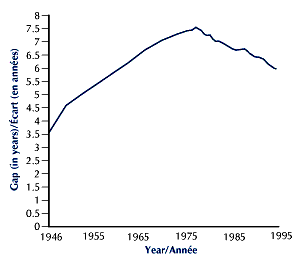Canada's changing life-expectancy trends
CMAJ 1997;157:1324© Canadian Medical Association
According to a recent Statistics Canada study, Canadian females can still expect to live longer at birth than males. However, the difference has shrunk from the 7.5 years reported in 1978 to 5.9 years in 1995. Life expectancy at birth is defined as the average number of years a person is expected to live if current age-specific death rates remain constant.Part of the change can be explained by trends in causes of death and associated risk factors. Traditionally, men have had more dangerous occupations, have participated in riskier activities and have generally had a less healthy lifestyle than women. This appears to be changing. The age-standardized death rate for cardiovascular disease has declined at a faster rate for men than women. This means the 1995 difference between the sexes was 123 more male deaths per 100 000 population, compared with a difference of 215 deaths in 1979. The death rate due to chronic obstructive pulmonary disease among females has jumped by 85% since 1979, and during the same period their death rate from lung cancer almost doubled, from 16.3 to 31.1 deaths per 100 000 people. Men, on the other hand, have experienced only slight increases in death rates for these 2 diseases.
Some risk factors associated with causes of death have also been tracked over time. Smoking rates have fallen for both sexes since the late 1970s, but more so for men than women: the difference in the proportion of males and females who smoke has shrunk from 11 percentage points to 4. There has also been an noticeable trend in the proportion of overweight Canadians. Females have experienced a 7% increase between 1985 and 1995, compared with 3% for males.
Gap in life expectancy at birth between males and females, Canada, 1946-1995

Source: Canadian Vital Statistics DatabaseThis column was written by Lynda Buske, chief, physician resources information planning, CMA. Readers may send potential research topics to Patrick Sullivan (sullip@cma.ca; 800 663-7336, x2126; fax 613 523-0937).
Send a letter to the editor responding to this article
Envoyez une lettre à la rédaction au sujet de cet article
| Other Pulse articles / Autres chroniques Médicogramme |